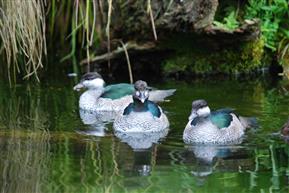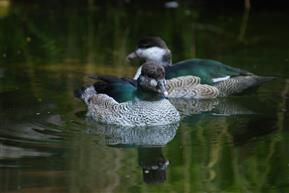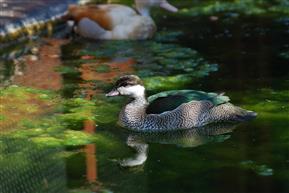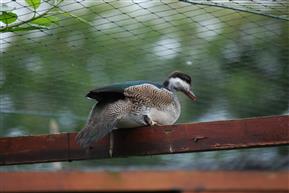Green (Australian) Pygmy Goose - Nettapus pulchellus
The Green Pygmy Goose is native to northern Australia, southern New Guinea and some Islands in eastern Indonesia where they can be found on fresh water lakes and dams and also on rivers where the flow is not fast. It is wholly aquatic, feeding primarily on water vegetation but will almost certainly consume insects and possibly even small fish. According to Peter Fullagar, Ducks, Geese and Swans, Volume 2, Oxford Press, numbers in the wild may be declining primarily due to the destruction of water vegetation by cattle and introduced Water Buffalo.
In captivity the Green Pygmy Goose is rare and with further imports unlikely its long term viability in captivity is in jeopardy unless some significant success can be achieved in the very near future to increase the captive population so that sustainable numbers can be established.
The Green Pygmy Goose is significantly larger than the African or Indian Pygmy Geese but like these species requires some protection from severe weather and ideally requires indoor accommodation during the winter but this requirement does not mean that they are a species that is more suited to a tropical house; although this might be ideal if the quality of the air and water could be controlled. In keeping with the African Pygmy Geese the Greens appear to be remarkably sensible and if provided with access to some sort of indoor set up that can provide frost free conditions during the winter they will invariably enter of their own accord and I have found that even during the summer they will tend to use the shelter at night. I only shut them inside if their outdoor pond actually freezes over.
Green Pygmy Geese are exceptionally beautiful birds, much of the feathering in both the male and females is highly iridescent and a male in full breding plumage in bright sunlight is really quite something. Many of the feathers on their flanks are laced and while at first glance the lacing appears black in good light this also shows a significant degree of iridescence that is quite spectacular. They have a range of whistling calls and when the male is in condition he will call quite loudly.
Feeding is relatively simple and they enjoy a good quality Foreign Finch mix and will also take some wheat. Getting them to take any quantity of pellets is not easy but should be encouraged, they will take some floating pellets, relish a supply of greens, some meal worms and if it were possible to provide water Lilly leaves and seeds this would probably be appreciated and may be very beneficial. Maintaining in captivity is not straight forward, they appear prone to getting wet feathers on their backs ind wing feathers and clearly this can lead to heat loss and subsequent hypothermia.
Breeding the Green Pygmy is something that I have yet to achieve, in June and July they become very vocal and display almost constantly and will fly up to nest boxes and show all the signs of wanting to breed but to date they have not actually produced any eggs. The males appear to take a significant part in the choosing of nest sites and will stand on nest boxes and very positively call the females to the box. While I have not kept my Green Pygmy Geese with any other species their general behaviours strongly suggests to me that when in breeding condition they may be quite aggressive to other waterfowl and I have observed aggression between my females and certainly have suspicion that the females when in condition may also be aggressive to males that are not in condition.
Green Pygmy Geese

Trio of Green pygmy geese, the male is only a year old and full breeding plumage is not attained until the second year.

Pair Green Pygmy geese.

Adult female Green pygmy goose, note the intensity of the green iridescence.

Adult female, as with other pygmy geese they really appreciate being able to perch on branches etc. over the water.





